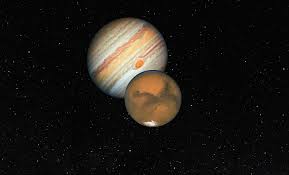Scientists have long debated the fate of the water that once covered Mars. While some of it has seeped deep underground, a significant portion has vanished into space. Evidence indicates that water molecules broke apart into hydrogen and oxygen atoms, with hydrogen escaping through the Martian atmosphere. By analyzing data from Hubble and MAVEN, researchers measured the rates at which hydrogen and deuterium (heavy hydrogen) are lost to space.
They found that these escape rates fluctuate significantly depending on Mars’ proximity to the Sun, challenging the previous assumption that atoms slowly diffused upward before escaping. This new understanding allows scientists to better reconstruct the history of water on Mars by tracing the escape rates over time.
Mars was once covered in water, as shown by its surface features. Over the last 3 billion years, some of this water likely seeped underground, but scientists are still investigating the fate of the remaining water. NASA’s Hubble Space Telescope and MAVEN mission are key to solving this mystery.
According to John Clarke from Boston University, there are two main ways water can disappear: it can freeze into the Martian soil, or the water molecules can break into hydrogen and oxygen atoms, which then escape into space. To determine how much water Mars originally had and what happened to it, scientists need to understand how these atoms escape.
Clarke’s team used data from both Hubble and MAVEN to measure how much hydrogen is currently escaping from Mars. By analyzing these escape rates, they can trace back and reconstruct the history of water on Mars.
Hydrogen and Deuterium Escape Dynamics.
Water molecules in Mars’ atmosphere are broken down by sunlight into hydrogen and oxygen atoms. The researchers specifically studied hydrogen and deuterium, a heavier form of hydrogen that contains an extra neutron. Due to this additional mass, deuterium escapes into space more slowly than regular hydrogen.
As more hydrogen escapes over time compared to deuterium, the proportion of deuterium in the atmosphere increases. By measuring this current ratio, scientists can estimate how much water Mars had during its wetter past. Analyzing the escape rates of these atoms helps them understand the historical processes affecting water loss over billions of years.
While MAVEN collected most of the data, it couldn’t always detect deuterium emissions throughout the Martian year due to seasonal variations. Hubble’s data was used to fill in these gaps, providing a complete view of hydrogen escape over three Martian years and extending back to 1991, before MAVEN’s arrival. This combined data offers a comprehensive picture of how hydrogen atoms are escaping from Mars.
A Turbulent and Dynamic Martian Atmosphere.
Recent research has revealed that Mars’ atmosphere undergoes more dramatic changes than previously understood. Scientists discovered that the atmosphere experiences rapid heating and cooling, with fluctuations occurring on timescales as short as hours. This turbulence is influenced by the varying brightness of the Sun, which changes by about 40 percent over a Martian year.
The escape rates of hydrogen and deuterium from Mars were found to vary significantly, especially when the planet is near the Sun. Previously, scientists thought these atoms slowly moved upward through the atmosphere before escaping into space. However, the new data shows that the process is much faster, with water molecules rising quickly and releasing atoms at higher altitudes when Mars is closer to the Sun.
Additionally, the rapid changes in escape rates suggest that the atoms need extra energy to escape Mars’ gravity. At the high altitudes where escape occurs, only a few atoms have enough speed to leave the planet. This extra energy is provided by events such as collisions with solar wind protons or chemical reactions driven by sunlight in the upper atmosphere.
Mars as a Proxy for Exoplanet Studies.
Studying Mars’ water history is crucial for understanding not just our own solar system, but also how similar Earth-sized planets evolve around other stars. As astronomers discover more such planets, detailed study is challenging. Mars, Earth, and Venus are all located in or near the habitable zone of our solar system, where conditions might allow for liquid water. Despite this, each planet has very different current environments.
By comparing Mars with Earth and Venus, scientists can gain insights into the conditions of distant exoplanets in our galaxy. The findings of this research were published in the July 26 edition of Science Advances.











